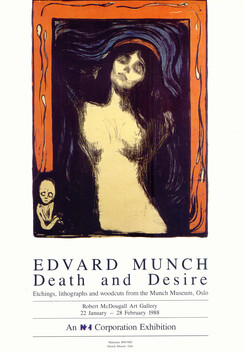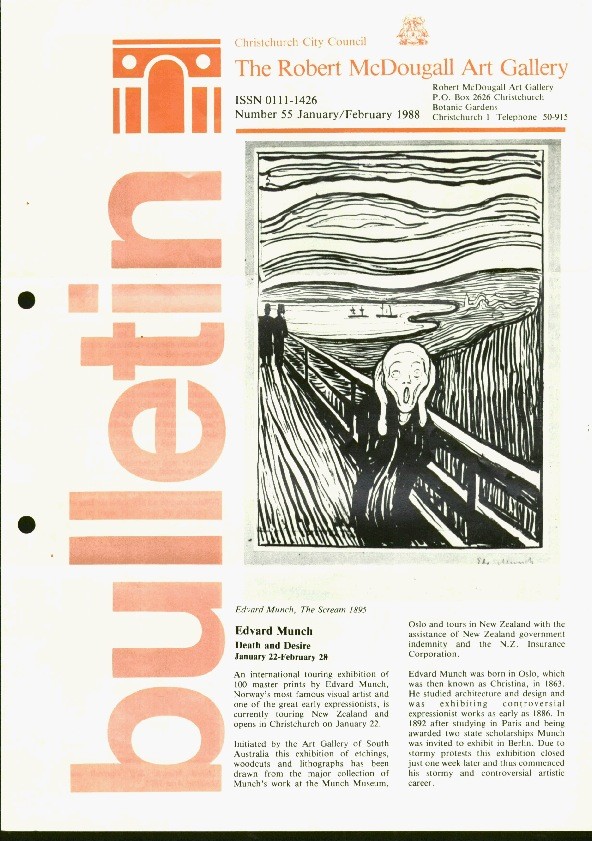This exhibition is now closed
Edvard Munch: Death and Desire
22 January –
28 February 1988

Poster for the Edvard Munch: Death and Desire exhibition (detail)
Etching, lithographs and woodcuts from the Munch Museum, Oslo
An international touring exhibition of 100 master prints by Edvard Munch, Norway's most famous visual artist and one of the great early expressionists is currently touring New Zealand and opens in Christchurch on January 22.
Initiated by the Art Gallery of South Australia this exhibition of etchings, woodcuts and lithographs has been drawn from the major collection of Munch's work at the Munch Museum, Oslo and tours in New Zealand with the assistance of New Zealand government indemnity and the N.Z. Insurance Corporation.
Edvard Munch was born in Oslo, which was then known as Christina, in 1863. He studied architecture and design and was exhibiting controversial expressionist works as early as 1886. In 1892 after studying in Paris and being awarded two state scholarships Munch was invited to exhibit in Berlin. Due to stormy protests this exhibition closed just one week later and thus commenced his stormy and controversial artistic career.
His next move was in 1896 when he returned to Paris the hub of contemporary art and the centre of innovative printmaking at that time. Here he associated with Rousseau, Vuillard, Greig, Delius, Strindberg and Gauguin and many other artists, musicians and writers interested in pioneering new thoughts, images, sounds and techniques.
A new interest in the very old technique of the woodcut was concerning many artists at this time. Gauguin, after his return to Paris in 1893 from his first sojourn in Tahiti, was experimenting in woodcuts of his exotic Tahitian themes. The new German Expressionists of Die Brücke and Der Blaue Reiter were also using the woodcut in their early manifestoes.
Like them, Munch found in the revival of the woodcut an exciting new range of expressive possibilities. He also developed his own truly revolutionary techniques. When making a coloured print, instead of cutting a block for each colour, Munch cut the block itself into separate parts with a fret saw. Each part was then inked in a separate colour and reassembled, to be printed as a single block. It was in the way that Munch was able to emphasise and exploit the lines between the blocks as major lines within the compositions.
In time he also explored ways to incorporate cardboard stencils and linoleum blocks to extend the range within the print. This experimentation with printing techniques continued throughout his life. By the year of his death in 1944 munch had created, in addition to his numerous paintings, close to 800 different etchings, woodcuts and lithographs.
Munch's imagery was always centred on the human condition. The emotional, and the psychological aspects of death, despair, genius, anxiety, loneliness, love and desire were his subjects. It was in capturing within the visual image these highly charged emotional states that Munch's controversial reputation arose.
Munch said in a note written about 1930, "In my art I have tried to arrive at an explanation of life . . . . I thought this might also help others to clarify their lives."
His poignantly haunting image of a shrieking, sexless creature in The Scream has a visceral clarity which makes it one of the truly powerful images of the 20th century art.
('Edvard Munch: Death and Desire', Bulletin, No.55, January/February 1988, pp.1-2)
Location:
Robert McDougall Art Gallery - main gallery
Exhibition number: 398



